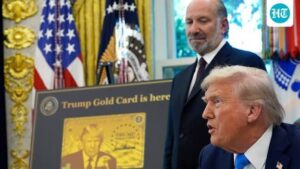Trump’s H‑1B Overhaul: Paying $100K or Moving Out

Trump will levy a new $ 100000 fee for H -1B visa, increase costs for employers and re -prepare US recruitment. Today we will discuss about Trump’s H‑1B Overhaul: Paying $100K or Moving Out
Trump’s H‑1B Overhaul: Paying $100K or Moving Out
In September 2025, the U.S. immigration landscape shifted dramatically for skilled foreign workers under the H-1B visa program. A proclamation signed by President Donald Trump introduced a $100,000 fee for new H-1B visa applications—a striking increase aimed at reshaping who is eligible to work in the U.S. under this program. For many, the choice is now stark: pay up or reconsider plans to work in the U.S.
This article examines what the changes are, who they affect, the arguments for and against, and what this might mean for companies, workers, and global competitiveness.
What Exactly Changed

Some of the key features of the overhaul include:
-
$100,000 Fee for New H-1B Applications
The new rule requires a one‐time payment of $100,000 by employers for new H-1B visa petitions. -
Scope & Timing
-
The fee applies to new petitions filed for foreign nationals outside the U.S. after a certain effective date (September 21, 2025) at 12:01 AM ET.
-
It does not apply to current H-1B visa holders, even if they are abroad or traveling, or to renewals of visas issued before the rule’s start.
-
-
Controversies Over Annual vs One-Time Fee
There has been confusion about whether the $100,000 fee is annual or one-time. Some statements from Commerce Secretary Howard Lutnick suggested it might be annual, while others clarified it’s a one-time fee for the application. -
Other Accompanying Changes
-
The policy pushes for higher prevailing wage levels to prevent H-1B holders from being hired at relatively low salaries.
-
There is also rhetoric about restricting “abuse” of H-1B visas, protecting U.S. workers, and making the program more selective.
-
Who Is Affected
The changes impact multiple stakeholders in different ways:
-
New Applicants
Anyone applying for an H-1B visa from outside the U.S. for the first time (or filing new petitions under the new rules) will need to factor in the $100,000 fee. -
Employers/Sponsors
U.S. firms that rely on hiring foreign skilled workers may face steep increases in cost if they sponsor many new H-1B holders. Smaller companies, start-ups, or ones that hire large numbers of skilled workers from abroad are particularly exposed. -
Current H-1B Holders and Their Families
The policy does not retroactively impose the fee on renewals or existing visa holders issued prior to September 21, 2025. Still, there is anxiety around travel, re-entry, and future policy shifts. -
Foreign Governments
Countries like India, which supply many of the skilled workers under the program, have raised concerns about “humanitarian consequences” and the effects on families. -
U.S. Tech, Healthcare, and STEM Industries
Industries that traditionally depend on global talent (especially tech, biotech, engineering) may face a tighter pipeline of skilled workers. The cost increase may lead to reshuffling hiring strategies.
The Rationale: Why $100K?
Understanding what the administration says it intends helps in evaluating the policy.
-
Protect American Workers
The government claims the goal is to prevent companies from hiring foreign workers at wages lower than U.S. norms, thereby undercutting domestic labor. -
Reduce Abuses and Loopholes
Allegations of misuse of the H-1B program (e.g., offshoring, “body-shopping,” replacing U.S. graduates) are being invoked to justify stricter financial barriers. -
Raise Revenue & Discourage Over-Reliance on Foreign Workers
Implicit is the idea that raising the cost will make employers more selective, consider domestic hiring, or invest in training U.S. workers. -
“Pay to Stay” / Merit over Volume
The policy seems designed to favor “premium” or high-paying roles rather than large volumes of lower-wage skilled roles.
Arguments Against the Overhaul
As with most major policy shifts, there are strong counterarguments and concerns:
-
Chilling Effect on Talent and Innovation
If access becomes too expensive or uncertain, top global talent may choose other destinations (Canada, Europe, Asia) for opportunities. This could hurt U.S. competitiveness, especially in fast-move sectors like AI, biotech, etc. -
Impact on Smaller Companies
Big tech firms may absorb the cost more easily, but startups and smaller firms may be pushed out of hiring foreign talent altogether, reducing diversity and innovation. -
Family and Humanitarian Disruption
Immigrant families could be disrupted. Also, there are concerns that abrupt changes may leave people stranded abroad or unable to travel without incurring huge costs or delays. -
Legal & Constitutional Questions
Some experts argue that executive orders or proclamations cannot impose such fees without Congressional approval, or that the rulemaking process required (including notices, comment periods) has not been followed. -
Economic Consequences
Sectors relying on foreign skilled labor may see labor shortages, wage inflation, slower growth. There might be unintended consequences such as offshoring, automation, inflated costs for consumers.
What “Move Out” Means: Alternatives, Responses, Reactions
The phrase “or moving out” captures how some foreign workers or companies may respond if the barriers become too high. Here are possible reactions:
-
Relocating Operations to Other Countries
Companies might scale up R&D or engineering centers outside the U.S. to avoid the high cost of bringing employees under H-1B. -
Hiring Local Talent or Investing in Domestic Workforce
A push could occur toward training U.S. students, adjusting hiring practices, or shifting more roles to be remote or offshore. -
Seeking Other Visa Pathways
Alternative visas like O-1 (for “extraordinary ability”), EB-1A (for “extraordinary achievement”) or even investor visas may become more attractive. Companies/workers may navigate those, though they have their own eligibility challenges. -
Not Applying or Delaying Applications
Some may choose not to apply under H-1B due to cost and uncertainty, or postpone until the policy is clarified or possibly overturned via courts or change in administration. -
Legal Challenges
Lawsuits are already expected. Immigration and business groups may challenge the fee’s implementation, its legality, or seek injunctions.
Immediate Practical Guidance for Those Affected
If you’re a prospective or current H-1B worker, or an employer, here are steps to consider:
-
Check the Issuance Date of the Visa / Application
If your visa was granted before September 21, 2025, or if you’re renewing an existing visa, you may be grandfathered from the fee. -
Avoid International Travel if Unclear
There have been memos from Big Tech companies urging foreign workers abroad to return to the U.S. before the fee comes fully in force, due to ambiguity in how re-entry is handled. -
Prepare for Higher Costs and Adjust Budgets
Employers should rework their budget forecasts for immigration, wage commitments, and overall hiring strategy. -
Stay Alert for Official Guidance
Regulations are often followed by detailed guidance from USCIS, Department of Labor, or other agencies. Clarifications (such as whether the fee applies to change-of-employer or amendment petitions) are likely. -
Legal Counsel and Advocacy
Those impacted should consult immigration lawyers. Companies may want to engage industry groups and lobby for modifications or exemptions.
Long-Term Implications
-
Global Competitiveness
These changes may shift global flows of talent. Countries that offer more predictable or cheaper access may attract individuals who formerly would have opted for the U.S. -
Shift in Immigration Policy Norms
The U.S. may increasingly favor “pay for privilege” models (large fees, premium visas) over traditional merit or employer-sponsor ones. -
Labor Market Adjustments
Increased pressure on U.S. education and training systems, especially STEM fields, to produce more domestic skilled labor. Also, companies may increase automation or outsource more roles. -
Policy Uncertainty and Market Instability
Businesses thrive on predictability. Abrupt changes to visa regimes can lead to disruptions in hiring, project planning, and investment.
Critique: Are There Better Paths?
Given the concerns, what alternative or complementary policy designs might address the same goals (protecting U.S. workers, reducing abuse) without such a blunt cost barrier?
-
Targeted Wage Floors
Instead of a blunt high fee, ensure that H-1B positions meet wage levels that prevent undercutting of U.S. workers. -
Enhanced Enforcement and Auditing
Actively policing fraud or misuse, ensuring that H-1B positions are genuinely needed, not just cost-saving tools. -
Tiered Fee System
Charging fees based on employer size, sector, or salary level rather than a flat block could mitigate pressure on smaller firms. -
Incentives for U.S. Hiring & Training
Tax incentives or support grants for firms that hire and train domestic workers, reducing reliance on foreign skilled labor. -
Gradual Implementation & Transition Periods
Phasing in changes gives companies and applicants time to adjust; providing grandfathering clearly and explicitly.
Global & Geopolitical Angle
-
Impact on India
Over 70% of H-1B visa holders are Indian nationals. India has already expressed concern about “humanitarian consequences.” -
Talent Migration Flows
Countries like Canada, Australia, Germany, and others may benefit by drawing in talent dissuaded by high U.S. entry costs. -
Bilateral Tensions
Visa policy shifts often feature in foreign policy dynamics. Reactions from affected governments could affect cooperation in tech, education, migration treaties.
Legal Architecture & Constitutional Questions
Under U.S. law, nonimmigrant visa fee structures are generally regulated by statute, and changes typically undergo rulemaking procedures, including notice-and-comment periods. Imposing such a large fee via proclamation or executive order may raise:
-
Separation of Powers Issues
Some may argue that Congress, not the executive, has authority over appropriations and fees. -
Due Process or Equal Protection Claims
If the policy is applied inconsistently or without sufficient justification, it may be challenged under constitutional principles. -
Statutory Constraints
Existing immigration statutes may define permissible fees and conditions; sweeping changes could face lawsuits for exceeding executive authority.
Will It Stay or Be Reversed?
Historical precedents and political dynamics suggest the possibility of changes:
-
Court Challenges may delay or block implementation, or require revision.
-
Public & Business Pressure could lead to legislative or administrative responses. Tech industry, universities, and foreign governments are already voicing concerns.
-
Future Administrations may reverse, modify, or refine the policy depending on political alignment.
-
Implementation Practicalities sometimes force loosening of strict rules (waivers, exemptions, clarifications) when impacts become evident.
Conclusion
Trump’s H-1B overhaul—centered around a sweeping $100,000 fee for new applicants—represents one of the most dramatic shifts in U.S. high-skilled immigration policy in recent memory. For those contemplating working in the U.S., for companies assembling global teams, or for governments sending skilled workers abroad, the message is clear: the cost of entry just got much higher, and many of the old assumptions no longer apply.
While the intent to protect U.S. workers, raise wage standards, and reduce misuse of the visa system has resonance, the scale and speed of change bring significant risk: to innovation, economic growth, and the lives of thousands of people and families. Ultimately, whether this policy will uphold its goals—or falter amid legality, backlash, and global competition—remains to be seen.
How useful was this post?
Click on a star to rate it!
Average rating 0 / 5. Vote count: 0
No votes so far! Be the first to rate this post.
About the Author
usa5911.com
Administrator
Hi, I’m Gurdeep Singh, a professional content writer from India with over 3 years of experience in the field. I specialize in covering U.S. politics, delivering timely and engaging content tailored specifically for an American audience. Along with my dedicated team, we track and report on all the latest political trends, news, and in-depth analysis shaping the United States today. Our goal is to provide clear, factual, and compelling content that keeps readers informed and engaged with the ever-changing political landscape.




